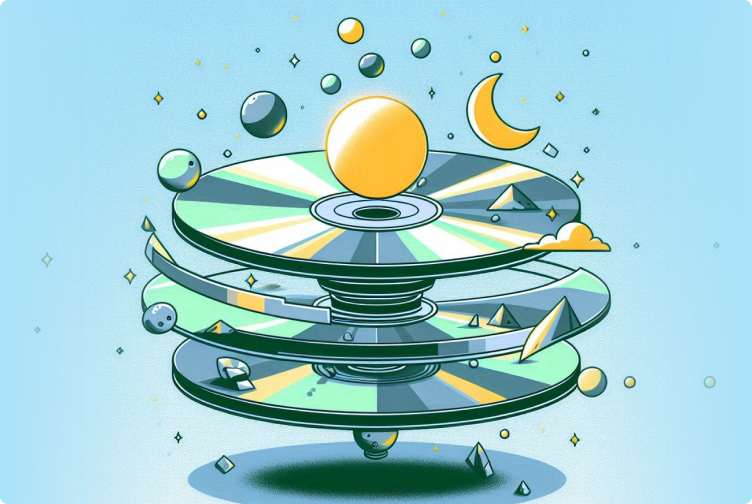
This is an extract from the OPIP book. Previously, B(obby) tried to convince A(lice) of the subjective nature of reality. Alice wasn’t convinced, so Bobby is providing yet another example…
B: Imagine we’re living in a world of rotating discs. Like compact discs (CDs), they store information with “lands” (unaltered areas on the disc’s surface) representing a “1” and “pits” (tiny indentations) representing a “0”.
A: So that a laser can read the information from the rotating discs?
B: In our imaginary world, let’s say we can only read discs if we bring them to a halt. Once stopped, our subconscious mind counts how many lands are on the left-hand side of the disc. If it’s more lands than pits, we perceive that side of the disc as being black, otherwise it’s white. That outcome is the only thing we’re aware of.
A: You mean the entire world looks black and white to us, and we don’t know that our subconscious mind creates it as you just described?
B: Yes. Furthermore, for simplicity, let’s assume that there are an equal number of lands and pits on the disc. Therefore, if we stop the disc, the probability that we perceive the left-hand side of the disc as black, or white, is 50%.
A: I wonder where you’re going with this.
B: It’s about drawing parallels. Let’s ask questions that are common when dealing with entangled particles in physics. First question: What’s the color before we stop the disc?
A: It doesn’t have any color.
B: Right. We create the color in our minds. If we still wanted to stick to our fundamentally flawed black-and-white thinking, how could we best describe the situation before having made any measurements?
A: Maybe we could call it a “superposition” of both black and white…
B: That would come closest, yes. However, that’s not what it really is. Before we measure it, it was neither black, nor white, nor anything in between. It’s the same in quantum physics. It’s not really a particle with certain characteristics (e.g., spin up or down), or even a particle at all, before we check it. Only our actions and interpretations create that impression when we make the measurement.
A: Okay.
B: Next question: what’s the best way we can predict if the left-hand side is going to be black or white?
A: Via probabilities.
B: Right. And those probabilities aren’t a characteristic of nature per se. We just don’t have the information about the discs, i.e., how many lands and pits there are, how fast the disc is rotating, and so on.
A: In this example, yes.
B: Next question: after your subconscious mind counted the number of lands and pits on the left-hand side of the disc, what else do you know?
A: I then know the situation on the right-hand side of the disc. Those two are perfectly correlated.
B: Right. If you know one, you know the other. Although, don’t forget: the perception of white and black still has to be created. It’s not a characteristic of nature. It has to be processed and may take a little time.
A: I get the parallel, but what would be the point of the subconscious mind to simplify reality like that?
B: What’s the main purpose of the conscious mind? It’s to make decisions, right? And for that, it needs actionable information. Imagine your conscious mind was flooded with the millions of lands and pits. It would be information overload, and you couldn’t make any decisions. The subconscious mind does a tremendous job in translating the information into the key pieces that are relevant for us, so that we can make good decisions. “Good” in this sense primarily means to take actions that are beneficial to our genes’ reproduction.
A: In theory it could make sense, but do you have any practical examples?
B: Let’s think about our bee again. At least in some respects, it has a much simpler understanding of the world than we do. Imagine it knew more, similar to a human. Or, taking an extreme case, let’s say you were the bee. Do you think your sophisticated knowledge would help you to survive? Of course, it wouldn’t. You’d probably not even last a day.
A: So knowing more than needed could even hurt us.
B: Right. There’s an incentive for evolution to not tell us the full story. In fact, there’s even a strong incentive to modify the story to whatever helps us to survive and reproduce.
To read more, get the OPIP book.
